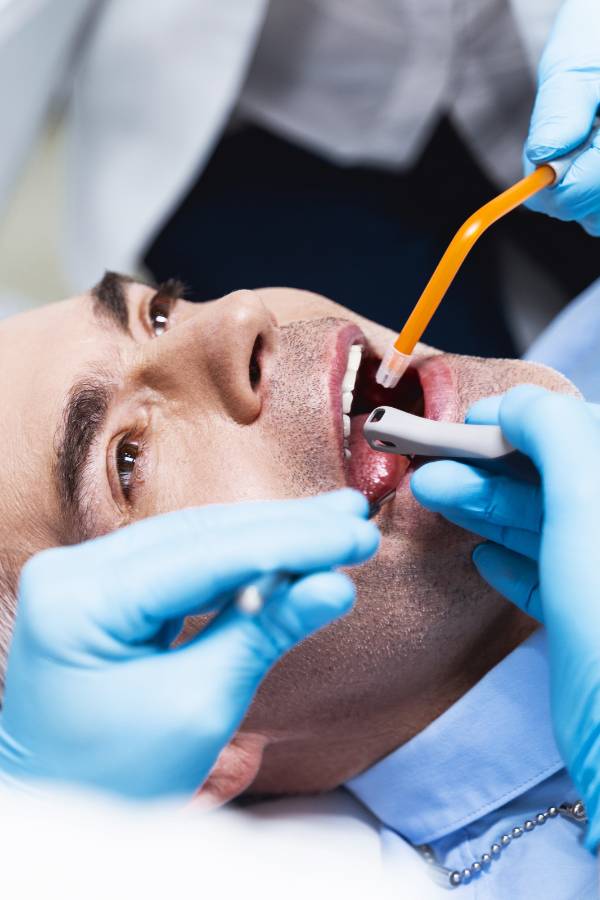General Dentistry
Achieve a Beautiful & Healthy Smile with general dentistry in mississauga
Your smile is part of your identity. Having healthy teeth allows you to express yourself confidently and speak clearly, in addition to being an important part of your overall health. That’s why, regardless of your age, it’s crucial to practice good oral hygiene and receive routine preventative and restorative dental care. Looking after your teeth today ensures you’ll enjoy the many benefits of a healthy, functional smile for decades to come.
To make looking after your teeth easier, Dr. Oscar Dalmao offers comprehensive general dentistry services conveniently located in Mississauga. Whether you need something as simple as professional teeth whitening or a full mouth restoration, our team of committed experts will manage your care from start to finish in a calm, comfortable setting. To learn more about the dental services we offer, refer to the treatment overviews provided below.
Some Advanced General Dentistry Services Include:

Teeth Whitening
As we age, our teeth naturally get darker. Certain lifestyle habits, such as smoking and consuming tea, coffee, and red wine, can also contribute to surface stains on the teeth. Although these changes are normal and don’t necessarily indicate poor dental health, many people understandably wish to brighten their smile. Fortunately, teeth whitening is a cosmetic dentistry procedure that can be done by a general dentist to quickly remove unsightly stains and make your teeth whiter without damaging your enamel. Unlike over-the-counter whitening kits, which can cause burns and dental problems, teeth whitening performed at a dental office is completely safe and effective.
How is Teeth Whitening Performed?
Professional teeth whitening can be performed in-office by our dental team, or we can prepare a set of convenient take-home whitening trays custom-fitted to your bite. In both cases, teeth whitening is a fast and very affordable procedure.
If you choose to have your teeth whitened in our dental office, we’ll apply hydrogen peroxide gel to your teeth, then expedite the whitening process with a UV lamp. For most patients, optimal whitening can be achieved in just one visit.
If you would prefer to whiten your teeth at home, we’ll start by taking an impression of your teeth. Then, we’ll create a set of trays molded to fit your bite. You will need to apply these trays for about 30 minutes per day for a week to whiten your teeth.
Composite Fillings (White Fillings)
Composite fillings, also known as white fillings, are a common treatment, done by general dentists for dental caries (cavities). They can also be used to repair small chips and cracks in the teeth. Composite fillings are made of a durable composite resin material that’s tinted to match the patient’s natural tooth enamel. Dental fillings restore the shape, appearance, and strength of damaged teeth while preventing further decay.
What Happens When You Get a Filling?
The dental filling procedure is relatively straightforward: First, the affected tooth is numbed with a local anesthetic, ensuring complete patient comfort. Then, decayed material is removed and the tooth is thoroughly cleaned before the resin composite is applied in layers. Between applications, a UV light is used to cure and harden the resin. Finally, the filling is shaped, refined, and polished until it’s virtually indistinguishable from the rest of the tooth. The entire filling process is completed during a single dental appointment, and the resulting restoration typically lasts for many years.


Dental Crowns
Before placing a crown, your dentist will shave the affected tooth down to make room for the restoration. Then, he will take an impression of your teeth, which will be used to create an accurate mold for the crown. Once the crown has been manufactured, it’s permanently bonded to the tooth.
Traditionally, patients could expect to wear a temporary tooth cap while their permanent crown was being manufactured, then the crown would be cemented in place during a second appointment. Today, however, many dental offices use digital imaging and printing technology to manufacture crowns on-site, allowing the entire process to be completed in a single appointment.
Once your crown has been placed, it will protect and preserve your tooth for many years. Depending on the material used, crowns can last anywhere from 10-15 years or even longer.
Root Canal Treatment
Root canal treatment is used to relieve pain and prevent serious complications when the root (also known as the “pulp”) inside a tooth becomes infected. Infection can occur as a result of extensive tooth decay, untreated chips or cracks in the teeth, or (more rarely) due to chronic teeth grinding or repeated dental work. The purpose of a root canal is to stop the infection from spreading and save the severely damaged tooth, avoiding the need for more invasive procedures, such as tooth extraction, dental bridges, or implants.
What Happens During a Root Canal?
During a root canal, the tooth and the area around it are thoroughly numbed with a local anesthetic. Then, the infected pulp is removed from the roots of the affected tooth and the root spaces are cleaned and filled with a sealant and rubber compound. As a final step, a crown is generally placed over the tooth to strengthen and protect it.
Do Root Canals Hurt?
Though many patients are apprehensive about receiving a root canal, there’s no need to be. Modern anesthetics and dental techniques have advanced to the point where root canal therapy does not cause pain or discomfort. Most patients only experience mild tooth sensitivity for several days after treatment, which resolves on its own.


Tooth Extraction
In rare cases, a tooth becomes so damaged by injury or infection that the only option is to remove it. Other potential reasons for tooth extraction include overcrowding in the mouth or advanced periodontal (gum) disease.
What to Expect During Tooth Extraction?
Tooth extraction may be performed by either a general dentist or an oral surgeon. To prevent discomfort, the tooth is numbed with a local anesthetic, then the dentist or oral surgeon carefully loosens and removes it. In some cases, a few self-dissolving stitches are placed to close the gum flap over the socket and promote rapid healing. The entire tooth extraction process takes just 20-30 minutes, and it typically causes minimal discomfort. After the tooth has been removed, the socket is packed with gauze to stop any bleeding.
Following a tooth extraction, you will be given pain medication, antibiotics, and detailed aftercare instructions. It’s crucial to follow these instructions carefully to prevent issues such as “dry socket,” a painful condition where the blood clot becomes dislodged from the tooth socket. As long as you care for your mouth properly following a tooth extraction, you should heal within 5-7 days.
Dental Bridge
Dental bridges are used to hide the “gap” created by tooth extraction and prevent the teeth from shifting. Having a dental bridge placed after having a tooth removed will make it easier to chew and preserve the alignment of your bite, reducing strain on your other teeth and jaw.
What is a Dental Bridge?
A dental bridge is a custom device that contains an artificial tooth attached to two crowns. The crown portions of the bridge are fixed in place over the patient’s existing teeth, creating a strong, uniform biting surface. Like single dental crowns, dental bridges are made from extremely durable materials; typically, they consist of metal and porcelain elements fused together. Bridges are permanently bonded to the teeth and cannot be removed.
What to Expect When Getting a Dental Bridge
Dental bridges are prepared and fitted over the course of multiple appointments. First, the teeth on either side of the missing tooth (which are known as “abutment teeth”) are shaved down to allow for crown placement. Then, an impression is made of the patient’s teeth and a temporary restoration is placed to protect the treatment area. Once the bridge is ready, the patient will return to the office and it will be permanently attached to the abutment teeth.


Dental Implants
Dental implants provide an alternative method of restoring missing teeth. Dental implants may be a better choice than a dental bridge if you have multiple missing teeth or want to avoid altering your remaining teeth. Dental implants also offer superior protection against bone loss, as they directly support the tissues below the gum line.
What is a Dental Implant?
Dental implants are permanent artificial teeth; unlike other dental restorations, a dental implant should last a lifetime. Dental implants are created by attaching an artificial tooth to a metal base that’s been fused to the patient’s jaw.
How Are Dental Implants Inserted?
Placing a dental implant is more complex than other types of dental work, so it’s important to know what to expect before you begin this procedure. First, a tiny titanium post is surgically inserted into the jawbone and the gums are allowed to heal over it. The patient must then wait 4-6 months to allow the bone to grow around the implant. Once they have fused together, the gums will be re-opened and an abutment will be attached to the implant. The gums need to heal for another 1-2 weeks before the artificial tooth is attached to the abutment post. The final result of this procedure is a permanent tooth that looks, feels, and functions exactly like your natural teeth.
Periodontal Treatment
Gum disease, not tooth decay, is the leading cause of dental problems and tooth loss among older adults. Periodontal disease usually results from plaque that’s become trapped below the gum line (where it cannot be removed by brushing and flossing); however, smoking, certain medications, and health conditions can also play a role in gum disease. Without treatment, gum disease causes pain, bleeding gums, and bad breath; it also weakens the tissue and ligaments that support the teeth, eventually leading to tooth loss.
What are the Symptoms of Periodontal Disease?
Some signs you may have gum disease include:
- Gums that bleed easily when you eat, brush, or floss.
- Painful, tender, irritated gums.
- Bad breath (halitosis) and/or a metallic taste in the mouth.
- Loose or shifting teeth.
- Tooth sensitivity.
How is Periodontal Disease Treated?
One of the best ways to prevent and treat gum disease is to undergo regular dental cleanings, in addition to using medicated mouthwashes and practicing excellent oral hygiene. In more advanced cases, specialized “deep cleaning” procedures, such as scaling or deep planning, may be used to heal the gums. For most patients, these steps are sufficient to control gum disease. In rare cases, however, soft tissue grafts are required to replace areas where the gums have receded significantly.


Orthodontics
Ideally, orthodontic treatment should be pursued early in life (between the ages of 10-14) while the patient’s jaw structure and facial bones are still forming. However, it’s possible to correct bite problems at any age; adults may simply require a longer course of treatment or multiple treatments to achieve optimal results.
To align the bite, dentists typically use an orthodontic device, such as a retainer, brackets, or braces. Today, patients have the option of choosing either traditional braces or Invisalign. Invisalign is a clear aligner that slips over the teeth, gradually changing their position without being noticeable.
While you’re wearing braces, it’s important to practice excellent oral hygiene and have regular dental cleanings. Doing so will prevent food from becoming stuck in or around your braces, which can increase the risk of tooth decay. During your orthodontics appointment, we will work with you to create a plan to care for your teeth while they’re being aligned.
Want a free consultation from our dental specialists?
Contact Dr. Oscar Dalmao’s Mississauga dental office now.
TESTIMONIALS
What Others Say About Dr. Oscar Dalmao Dental Implants Center in Mississauga
